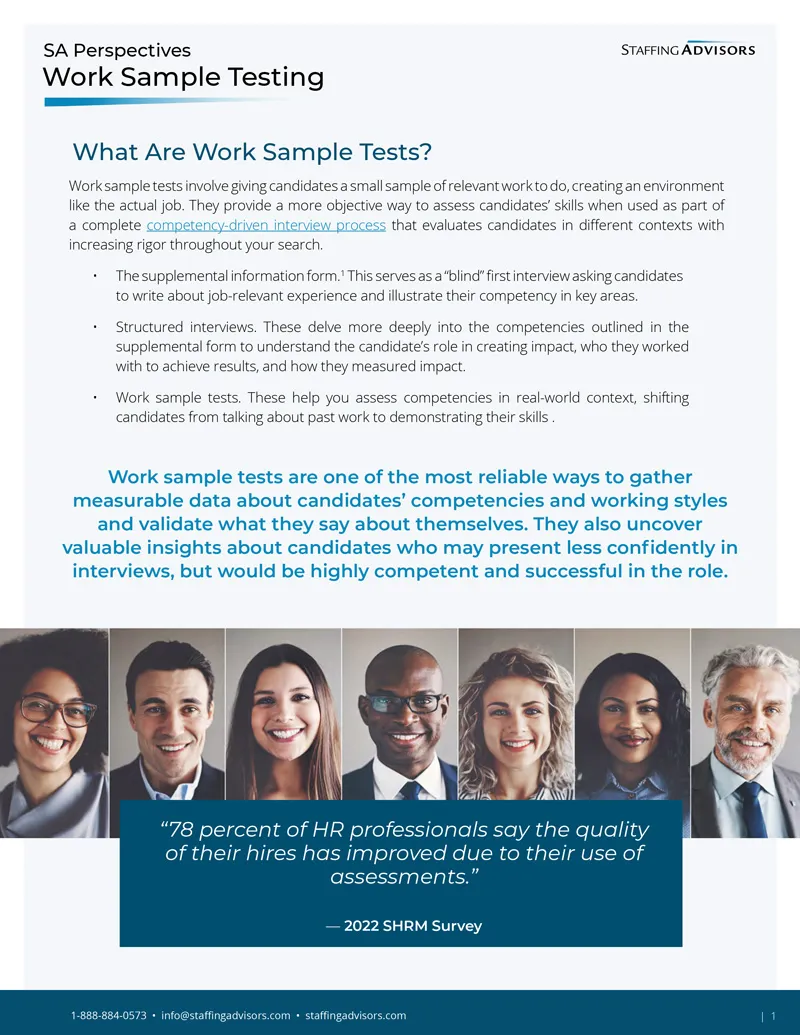Your goal during the hiring process is to select the candidate most likely to succeed in your role. But relying on resumes and free-flowing conversational interviews is risky. Research shows that those approaches are poor predictors of success on the job.
Instead, the Staffing Advisors team recommends using a succession of skills-based assessments that increase in rigor as the hiring process moves forward.
- Written prompts asking candidates to describe their experience in defined key competency areas.
- Structured interviews that explore those same competencies in-depth, focusing on how the candidate created impact, collaborated with others, and measured results.
- Work sample tests (sometimes called performance tasks or a case study interview) to assess these competencies in a real-world context, allowing candidates to demonstrate their skills rather than talking about past experiences.
Work sample tests are one of the most reliable ways to gather measurable data about candidates’ competencies and working styles and validate what they say about themselves. Once you’ve evaluated candidates in different ways—writing and talking about past work and demonstrating their skills during the work sample—you’ll have a rich set of data to compare against your organization’s needs.
What Are Work Sample Tests in Hiring?
A work sample test involves asking candidates to complete a small assignment similar to the actual work they’d do on the job. You then discuss their work together in an interview, just as you would review a project with a team member. The candidate’s role is to demonstrate how they work and how their skills align with the position. Your role is to ask questions, provide feedback, and assess how they work through problems.
To get the most value from this approach, actively engage the candidate during the discussion. Dig into why they made certain choices and how they’d adapt given new information or with different stakeholders involved.
How To Design a Work Sample Test
The content of your work sample exercise will vary by career level and functional area. Here is a basic structure to follow:
- Decide what you want to learn. Consider the 3-5 skills most essential to the role. What do you want to see in action? What will convince you that this person has the skills to do the job and collaborate with your team?
- Identify a challenge this person may face in their day-to-day work. Identify a challenge this person would face in their day-to-day work—something that would actually land on their desk. It should reflect the complexity and demands of the role while providing insights that interview questions alone cannot. The assignment should take no more than 2-3 hours to complete. We recommend giving candidates a week to complete it.
- Include some constraints and resources. Set parameters and be specific. Give candidates real information to work with to simulate your work environment: standard operating procedures, sample product portfolios, org charts, membership surveys, sales data, or other relevant materials.
- Develop evaluation criteria. How will you measure success? Are there multiple viable approaches to the work? Remember, you’re not just looking for the “right” answer—you’re evaluating thought processes and problem-solving approaches. Use the same criteria for every candidate.
- Ask candidates to come prepared to discuss. Tell candidates upfront that you want to understand the thinking behind their work. A deliverable alone won’t show you how they arrived at their conclusions or how they’ll adapt when circumstances change. If you choose to ask for a deliverable as part of the assignment, keep it simple and emphasize the importance of the discussion.
How To Discuss a Work Sample Test (and AI-Proof It)
After the candidate presents their ideas during the interview, follow-up with questions that reveal how they think and work. Be aware that candidates may use AI tools to prepare for the assignment—and that’s fine. AI is a resource like any other. But because AI can produce polished work for many scenarios, a good discussion is essential; it’s how you’ll differentiate candidates.
Their ability to explain their choices, defend their reasoning, and think on their feet will reveal far more than their initial work.
During the discussion, ask the candidate to present their approach, and then follow up with detailed questions. Propose a roadblock. Ask what they would change if different stakeholders were involved. Ask them to explain judgment calls. Challenge their thinking.
The Business Benefits of Work Sample Testing
Higher Quality Hires and More Diverse Teams
Interviews favor candidates who are good at talking about work, while skills-based assessments favor candidates who are good at working. Including both in your process reduces the potential for bias toward candidates with easy confidence or familiar credentials, invites candidates from various backgrounds to showcase their skills, and leads to better quality hires and more diverse teams.
More Accurate at Predicting Success on the Job
Extensive research shows that work sample testing is a more accurate predictor of success than the interview itself. A skills test allows you to see a candidate’s cognitive style, how they solve problems with a given set of resources, and how they organize their thinking.
Builds Commitment and Trust With Candidates
Candidates appreciate the opportunity to visualize themselves in the position and think about how their skills align and whether the work is something they want to do. They also want to demonstrate their strengths and increase their chances of getting hired. And for candidates from groups that are underrepresented in a functional area or industry, skills tests send a clear signal that you evaluate everyone consistently and fairly.
Improves Your Onboarding and Training
Skills assessments will reveal each candidate’s strengths and weaknesses in the context of your specific job and organization. This insight can be invaluable in structuring onboarding and training to give them the support they need to succeed in the role, leading to a better employee experience and long-term retention.
Saves Time and Resources
While developing work sample tests requires effort for your hiring team, these assessments save time and resources in the long run by helping you avoid hiring the wrong person. The additional information you gain helps you more clearly identify the tradeoffs you would make with one candidate over the other.
Take It With You
For work sample examples from association and nonprofit executive searches in different functional areas and career levels, download SA Perspectives: Work Sample Testing and share with your team. (No signup or email required.)

